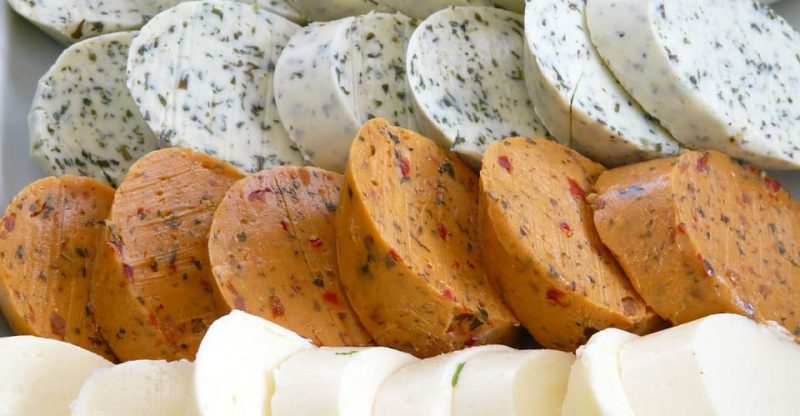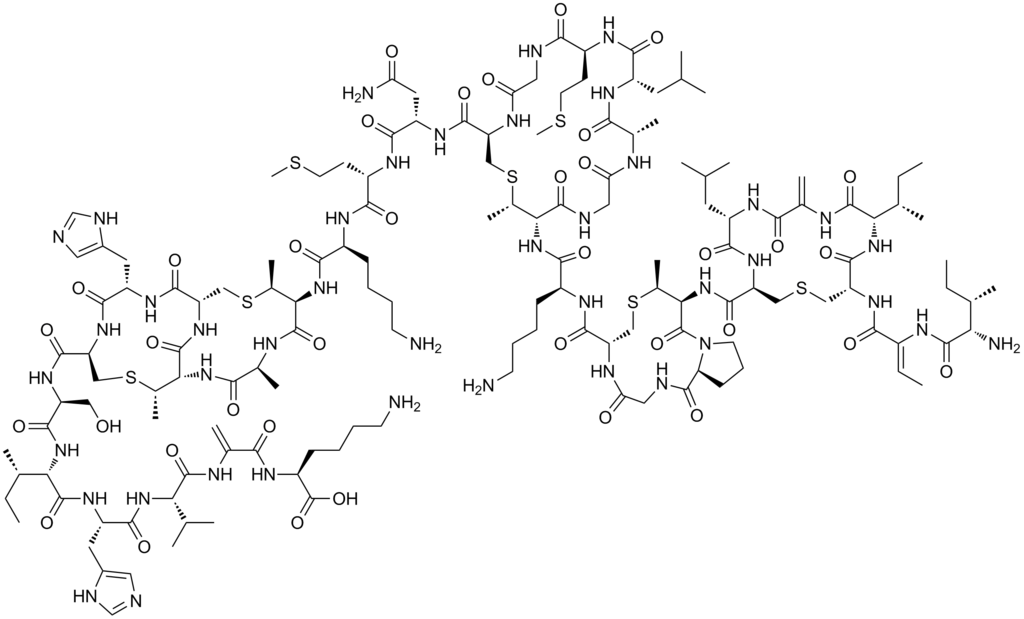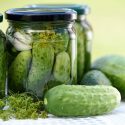What Is Nisin Preparation (E234) In Food? Uses, Safety, Side Effects

Nisin preparation | Production | Uses | Safety | Side effects | FAQs
Nisin (or more accurately Nisin A), also known as a lantibiotic, is a small-molecule polypeptide antibiotic with antibacterial activity, synthesized and secreted by Lactococcus lactis subsp. lactis during metabolism.
It is commonly used as a preservative in processed cheeses and meat products to inhibit Gram-positive spoilage and pathogenic bacteria. The European food additive number is E234. Generally, it is safe, natural, vegan (maybe), halal, kosher and gluten-free.
What is Nisin Preparation?
Nisin preparation is the commercial nisin sold in the market, available as a lyophilized (light brown) powder. It is made of three parts (2) :
- Nisin: 2.5% (w/w) and with a minimum hydrous potency 900 IU/mg.
- Sodium chloride: not less than 50% which is used to adjust the activity of nisin.
- Non-fat milk solids or solids from fermentation.
How is Nisin Made?
There is a manufacturing process of commercial nisin preparation mentioned by EFSA, and the following are the brief flow chart:
- Fermentation of a sugar-based medium with added yeast extract using the bacterium Lactococcus lactis subsp. Lactis.
- Extraction of nisin concentration.
- Spray dry: precipitated with sodium chloride and then through a spray-dried process.
- Nisin preparation: standardized with sodium chloride to obtain a potency of 1,000 IU nisin A/mg.
How does it Work?
Nisin can inhibit the growth of a variety of food spoilage Gram-positive bacteria, such as Bacillus subtilis, Staphylococcus aureus, Listeria and Clostridium botulinum, and it is particularly effective against spores that gram-positive bacteria that produces.
The main preservation mechanism of nisin is to bind to the anionic phospholipids (including lipid II) of the cell membrane and then inserted to the cell membrane.
These processes can stop all biosynthetic processes in Gram-positive bacteria, and therefore kill Gram-positive bacteria. The impermeability to cell walls of Gram-negative bacteria makes it ineffective to it. (3)
Specification
CAS Number
1414-45-5
Chemical Formula
C143H230N42O37S7
Molecular Weight
3354.12
Structure

Image Source
Properties
Appearance
Light brown powder.
Solubility
The water solubility increases with decreasing pH. Sparingly soluble at pH 7, 4% at pH 5.0, and 12% at pH 2.5. Insoluble in non-polar solvents.
Stability
The lower the pH, the higher the stability. Nisin has strong acid and high temperature resistance. Its thermal stability can be used for inhibiting various Gram-positive bacteria during food processing and preservation.
What are the uses of Nisin?
There is a long history of using fermentation of lactic acid bacteria to preserve food. The inhibitory effects of lactic acid and other organic acids produced during the fermentation are fully recognized, but the antimicrobial effects of nisin produced in the metabolism of lactic acid bacteria metabolism are gradually discovered in later studies.
Nisin can be used in cheeses, canned food, meat products to:
- Prevent food spoilage by inhibiting the growth of Gram-positive bacteria & the spores and result in extending storage time.
- Reduce food sterilization temperature & time and therefore reduce nutrition loss.
Canned Food
Nisin can help reduce the intensity of heat treatment, and therefore reduce the loss of nutritional components of the food in canned food. Meanwhile, it inhibits the growth and reproduction of heat-resistant spore-former and extends the food shelf life.
For example, adding nisin to pickles can reduce the amount of chemical preservatives sodium benzoate and potassium sorbate, and can also inhibit the growth and reproduction of lactic acid bacteria and Staphylococcus aureus.
Meat
Sodium nitrite and nitric acid are commonly used in the production of meat products as preservatives and color enhancements, but these two additives are harmful to the human body and may even cause cancer. Nisin can reduce the addition or replace sodium nitrite and nitric acid in meat products, the following are some of its applications:
- canned ham
- smoked pork
- salted pork
- Sausages
- vacuum-packed fresh beef
Also, nisin can inhibit the growth of Clostridium botulinum, the most common microorganism that leads to meat products spoilage.
Beer
In the beer processing process, microorganisms are easy to grow and cause microbial contamination. Nisin can inhibit the growth of Gram-positive bacteria, enhance the sterilization effect of hops on thermophilic bacteria without causing any adverse effects on the fermentation characteristics of beer yeast, thereby ensuring the quality and flavor of the beer.
Ice Cream
Ice cream is often contaminated by Listeria during the production process and Listeria can still be found even under ultra-low temperature conditions. Nisin can be used to inhibit the growth of Listeria.
Dairy
Milk is susceptible to be contaminated by various microorganisms during the process of production, storage, and transportation.
Pasteurization can only kill pathogenic microorganisms, but there are still other microorganisms that may exist and affect the preservation and shelf life. Nisin can inhibit Gram-positive bacteria, thereby prolonging shelf life.
In yogurt, the main purpose of nisin is not for preservation (as low pH, contaminating bacteria are mainly molds and yeasts, and nisin does not inhibit them) but to prevent post-acidification during storage, which is caused by lactic acid (produced by lactobacillus). Acidity affects the edible quality of the yogurt and makes ice cream taste bad.
Working with Natamycin and other Preservatives
Due to the narrow antibacterial spectrum of nisin, which can only kill or inhibit Gram-positive bacteria, therefore its application is limited, and the combined use of Nisin and other preservatives or acidulants (citric acid, lactic acid) can make up for this shortcoming, and then exert a broad-spectrum antibacterial effect.
It is sometimes used with natamycin for a synergy effect. Natamycin is also a biopreservative produced by the fermentation of streptomyces, effective in inhibiting the growth of various molds, yeasts and mycotoxins.
However, it is used only for the preservation of food surfaces due to its low solubility.
Is Nisin safe to Eat?
Yes, it is considered safer than chemical preservatives as it is natural and quickly hydrolyzed into amino acids in the digestive tract by proteolytic enzymes (trypsin, sialase, digestive enzymes, etc.) after oral ingestion.
It has been approved safe by U.S. Food and Drug Administration (FDA), European Food Safety Authority (EFSA), as well as Joint FAO/WHO Expert Committee on Food Additives (JECFA), and is being used in more than 50 countries.
FDA
Nisin preparation is Generally Recognized as Safe (GRAS) with a maximum level of 250 mg/kg of nisin in the finished product to use as an antimicrobial agent to inhibit the outgrowth of Clostridium botulinum spores and toxin formation in pasteurized (process) cheese spreads (with fruits, vegetables, or meats). (4)
Canada Health
It is permitted to be used in the following products (not totally included) with the maximum levels ranges from 2.5 – 30 ppm. (5):
- Baking mixes containing egg
- Concentrated juice
- Ready-to-eat meat/poultry meat/smoked fish
- Unstandardized processed cheese products, Sausage
EFSA
Nisin (E234) is listed in Commission Regulation (EU) No 231/2012 as an authorised food additive and categorized in “Additives other than colours and sweeteners” (6).
Evaluation in 2017
EFSA concluded that the use of nisin (E 234) as a food additive in unripened cheese and in heat-treated meat products would not be of safety concern as the exposure of nisin A was below the new ADI (1mg/kg). (7)
Authorised Uses And Use Levels
The following products may contain it with the maximum usage from 10mg/kg to 12.5mg/kg (8):
- Clotted cream
- Mascarpone
- Ripened/Processed cheese and products
- Pasteurised liquid egg (white, yolk or whole egg)
- Semolina and tapioca puddings and similar products
UK Food Standards Agency
Categorized in “Preservatives” (9)
Food Standards Australia New Zealand
In Australia and New Zealand are all with the code number 234. (10)
JECFA
Functional Class: food additives, preservative. (11)
Acceptable daily intake: ADI “2 mg/kg bw” set in 2013. (12)
What are the possible side effects?
Almost no reported side effects. It can reduce the allergy symptoms caused by the chemical preservative and may benefit the colorectal cancer patient (13).
Is Nisin safe during pregnancy?
Yes, it is generally safe but better consult your doctor in the condition of use.
Frequently asked questions
What is Nisin A?
Nisin A is the major polypeptide in nisin, which is a mixture of closely related antimicrobial polypeptides composed of 34 amino acids. Commonly nisin with the E number E234 and CAS number 1414-45-5 is referred to nisin A. There are also other nisin types, such as nisin Z, another natural occurring nisin variant, with a better solubility and antimicrobial effect than nisin A (14).
Is Nisin Vegan?
Maybe, it is not vegan if skimmed milk is used as the medium or otherwise it is vegan if a sugar-based medium is used as derived from non-animal source and meeting some vegetarians demands of natural food preservatives.
Is Nisin Gluten Free?
Yes, this ingredient is gluten-free as complying with the FDA’s definition of gluten free, that it does not contain wheat, rye, barley, or crossbreeds of these grains. And it is generally considered safe for people with celiac disease.
Is Nisin Dairy Free?
Maybe. Depending on the sugar medium or milk medium the manufacturer used. It is vegan if sugar medium is used such as dextrose.
Conclusion
Now I think you may have a good knowledge of preservative – nisin (E234), from production process, health benefits, uses, approved safety and possible side effects. Also you may be clear with some common FAQs such as is it gluten free, vegan and dairy free.
What kinds of food labels have you found this additive in? Let me know in the comments.



Hi
I need advice on how much nisin to use in my rice pudding product would you able to advise please?
Hi Khan,
You can try 40-60mg/kg.
Hi
I need advice on how much nisin to use in my process cheese product would you able to advise please??
thanks for including the info on if this is vegan/vegetarian, just what I was looking for!
Any knowledge on antimicrobial resistance & modulating effects on microbiome? Thanks
Currently no
Hi Saleem,
The max usage may from 10 mg/kg to 12.5 mg/kg in cheese products, details you can see here: https://efsa.onlinelibrary.wiley.com/doi/10.2903/j.efsa.2017.5063
Thank you, Dr.Han for sharing your knowledge. We have found Nisin in the ready-made Yukon Whipped Potatoes sold at The Fresh Market grocery store, in Bonita Springs, Florida–USA. Does this mean if we begin to feel sick, we should run to this store and load-up on the whipped potatoes? HaHaHa! What an easy fix! Brilliant! Of course, everything in moderation. But it’s comforting to know we have another natural ingredient in our arsenal of protection and preservation available in our food supply. Thank you, sir.
Sandie Treichel & Jaime Ziadie
Bonita Springs, Florida
I also had theYukon Gold Mashed Potatoes. I found them to have a somewhat unusual flavor unlike other mashed potato products. Having spent my entire career in the flavor industry, I’m very sensitive to flavor notes as we call them. Don’t know whether this is contributed by the Nisin or just the character of the species of Potato. Since you cooked the product for 45 minutes at 350, with that temperature and with clearly a lot of water present, it would not be unlikely that you would hydrolyse many of the amide linkages among the amino acids giving rise to many potential flavor precursors.
Hello there. I am trying to sell out my homemade ‘pandan’and coconut spread but still figuring out how much Nisin should i include in the 1kg recipe? Previously i tried with 2g of Nisin and the spread only lasted for a couple days 🙁 And should i try combining it with Natamycin as wwell?
Hi
I need advice on how much nisin to use in my khoya sweet product would you able to advise please
Hi Mr. james han
would you help me to determine which method to check nisin amount in food?
Hi, It’s the job of QC, you can see it the quality standard, such as USP, NF, FCC
I found it on ingredient list on Egglife Wraps, was researching to see if it was another form of dextrose. I noticed the wraps have slight powdery feel and wondering if maybe the Nisin is just being put on outside surface to protect from mold. Do you know if it can be used that way?
It was listed as an ingredient in the prepared mashed potatoes at the hot food bar in Whole Foods in Connecticut.
I have a question. There has been some talk recently that Nisin contains mRNA. Is there some misunderstanding here? Is mRNA added to commercial grade Nisin, or is it part of the production process?
I read: “Nisin is classified as a Type A (I) lantibiotic that is synthesized from mRNA”.
So my question is: Is there any mRNA left in the final product that goes into food?
Thank you.
Egglife egg wraps – we were checking out the ingredient list and had to research what Nisin was. Appreciated the article you wrote. 🌟
I first encountered it in Reser’s Ham Salad and was curious to determine what it entails. Your article is very thorough so thank-you for that. My question is: is nisin a good product to prevent spoilage in home canned products following all standard guidelines? Particularly tomato sauces and diced tomatoes?
How much nisin is to be added in south indian coconut chutney of 1 kg.